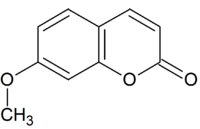Herniarin
From Wikipedia, the free encyclopedia
| Herniarin | |
|---|---|
 | |
| IUPAC name 7-Methoxychromen-2-one | |
| Other names 7-O-Methylumbelliferone | |
| Identifiers | |
| CAS number | 531-59-9 |
| PubChem | 10748 |
| ChemSpider | 10295 |
| ChEMBL | CHEMBL49732 |
| Jmol-3D images | Image 1 |
| |
| |
| Properties | |
| Molecular formula | C10H8O3 |
| Molar mass | 176.17 g mol−1 |
| Except where noted otherwise, data are given for materials in their standard state (at 25 °C (77 °F), 100 kPa) | |
| Infobox references | |
Herniarin is a natural chemical compound. Chemically, it can be considered a methoxy derivative of coumarin or a methyl derivative of umbelliferone.
Herniarin is found in Herniaria glabra,[1] Ayapana triplinervis and in species of the genus Prunus (P. mahaleb, P. pensylvanica, and P. maximowiczii).[2]
References
- ↑ "Herniarin". liberherbarum.com.
- ↑ Santamour F. S. and Riedel L. G. H. (1994). "Distribution and inheritance of scopolin and herniarin in some Prunus species". Biochemical systematics and ecology 22 (2): 197–201.
| |||||||||||||||||||||||||||||||
This article is issued from Wikipedia. The text is available under the Creative Commons Attribution/Share Alike; additional terms may apply for the media files.